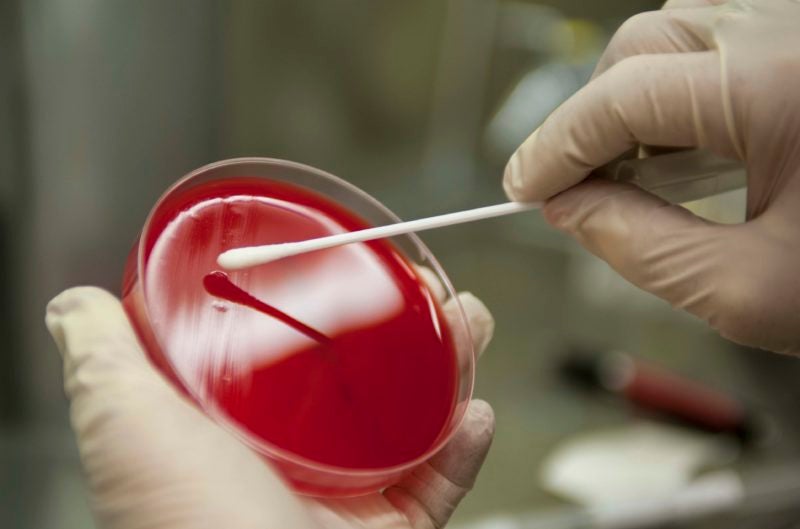
The Petri dish has been around for over a decade and yet the simple cell growing tools remain a permanent fixture in many laboratories around the world. The shallow cylindrical glass or plastic lidded dishes are most commonly used by biologists to make agar plates, which bacteria can be cultured upon. They are also useful for examining the efficacy of antibiotic drugs in development.
To make an agar plate a Petri dish much be partially filled with warm liquid containing agar and a mixture of ingredients that can include nutrients, blood, salts, carbohydrates, dyes, indicators, amino acids or antibiotics. Once the agar has cooled and solidified, the dish is ready to be inoculated with a sample. Virus or phage cultures require a two-stage inoculation.

Discover B2B Marketing That Performs
Combine business intelligence and editorial excellence to reach engaged professionals across 36 leading media platforms.
Petri dishes need to be incubated upside-down to lessen contamination risks from airborne particles landing on them and to prevent the accumulation of water condensation that could disturb or compromise a culture. Other than this, they are fairly straightforward to use and are now more commonly made of disposable plastic than glass so they can be thrown away after each use.
Although the Petri dish has not undergone significant change since its invention more than 130 years ago, it is associated with some of the greatest medical discoveries in recent history. From identifying plague bacteria to the discovery of penicillin to growing organs, the timeline of the Petri dish is far from as simple as its design.
Invention – 1887
The Petri dish is named after German bacteriologist Julius Richard Petri. Petri worked as a military physician for the German army and was assigned to a laboratory in Berlin’s Imperial Health Office in 1887. A scientist called Robert Koch ran the laboratory and was looking for a reliable pure culture technique for growing lots of bacteria.

US Tariffs are shifting - will you react or anticipate?
Don’t let policy changes catch you off guard. Stay proactive with real-time data and expert analysis.
By GlobalDataA lot of the earlier methods for bacteria growth were opened to the air, which resulted in cross-contamination. Building on methods such as the bell jar on a glass plate technique, Petri invented a culture dish very similar to the one we are familiar with today. He named the invention after himself and went on to write a 300-word paper about how to use the dish.
Identifying plague bacteria – 1894
During another outbreak of the plague in 1894 in Asia, a Swiss-French bacteriologist called Alexandre Yersin discovered that the Yersinia pestis bacterium was responsible for the condition. Yersin used Koch’s postulates technique to culture the bacteria on a Petri dish. He also identified which culture media optimised the development of the bacillus, thereby allowing scientists to reproduce the same conditions in their laboratory and study the microorganism.
Discovery of Penicillin – 1928
Perhaps one of the most famous pharmaceutical discoveries that the Petri dish can be attributed to is that of Penicillin. After returning from a holiday on September 3 1928, Alexander Fleming, a professor of bacteriology at St Mary’s Hospital in London, began to sort through his Petri dishes, which contained colonies of Staphylococcus. Staphylococcus is the bacteria responsible for the likes of boils, sore throats and abscesses.
Fleming noticed something unusual about one of his Petri dishes as it was dotted with colonies apart from in one area where a blob of mould was growing. The zone immediately around the mould, which was later identified as a rare strain of Penicillium notatum, was clear, and Fleming then concluded that ‘mould juice’ was capable of killing bacteria.
Fleming’s assistants Stuart Craddock and Frederick Ridley were then able to isolate pure penicillin from the so called mould juice.
The smart Petri dish – 2011
In 2011, researchers from the California Institute of Technology (Caltech) transformed the way cell cultures are imaged by creating a synthetic platform they referred to as a ‘smart’ Petri dish or the ePetri. The ePetri was designed to do away with the need for bulky microscopes and significantly reduce human labour time, while improving the way in which the culture growth can be recorded. A small camera in the dish can send data from the ePetri dish and transfer it to a computer outside the incubator by a cable connection. This is said to save time and reduce contamination risks.
Culturing brain tissue – 2017
Petri dishes successfully aided scientists at the University of Luxembourg in their attempts to turn human stem cells into brain-like cultures that behave very similarly to cells in the human midbrain. The research was conducted in 2011 and involved stem cells, derived from human skin samples, being grown on Petri dishes.
As the brain is the most complex human organ and research surrounding it faces many ethical implications, it can be extremely difficult to conduct experiments on it. The 3D brain tissue cultures can now allow scientists to study causes and tests treatments for neurodegenerative diseases such as Parkinson’s.
Growing organs – 2018
In more recent years, regenerative medicine has advanced rapidly and the Petri dish has played a role in the growing of skin grafts and organoids. Organoids are particularly important for the pharmaceutical industry because the impact of drugs can be observed on individual organs and they negate the need for animal testing.
In May 2018, scientists at Oregon State University confirmed that advances in stem cell research means that entire cell lineages or entire human organs could be grown in Petri dishes very soon.
In July 2018, bioengineers from Harvard University in the US developed a 3D model of the human heart’s left ventricle so they could conduct cardiac disease research and study the effects of a heart attack in a Petri dish.





